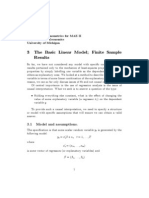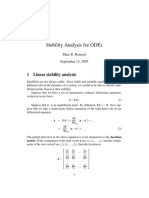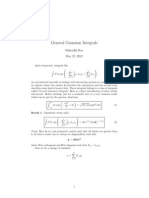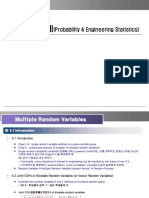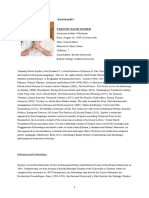Jacobian PDF
Jacobian PDF
Uploaded by
Gabriel Antonio Santos BaezCopyright:
Available Formats
Jacobian PDF
Jacobian PDF
Uploaded by
Gabriel Antonio Santos BaezOriginal Title
Copyright
Available Formats
Share this document
Did you find this document useful?
Is this content inappropriate?
Copyright:
Available Formats
Jacobian PDF
Jacobian PDF
Uploaded by
Gabriel Antonio Santos BaezCopyright:
Available Formats
The Jacobian
The Math
Most mechanisms of interest to computer animation are too complex to allow an analytic solution. For these, the
motion can be incrementally constructed. At each time step, the best way to change each joint angle in order to
direct the current position and orientation of the end effector toward the desired configuration is computed. The
computation is preformed by forming the Jacobian matrix which is a matrix of partial derivatives.
In order to explain the Jacobian from a strictly mathematical point of view, consider the six arbitrary functions of
EQ 1, each of which is a function of six independent variables. Given specific values for the input variables, the
xis, each of the output variables, the yis, can be computed by its respective function.
y 1 = f 1(x 1, x 2, x 3, x 4, x 5, x 6)
y 2 = f 2(x 1, x 2, x 3, x 4, x 5, x 6)
y 3 = f 3(x 1, x 2, x 3, x 4, x 5, x 6)
. (EQ 1)
y 4 = f 4(x 1, x 2, x 3, x 4, x 5, x 6)
y 5 = f 5(x 1, x 2, x 3, x 4, x 5, x 6)
y 6 = f 6(x 1, x 2, x 3, x 4, x 5, x 6)
The differentials of yi can be written in terms of the differentials of xi using the chain rule. The generates EQ 2.
δfi δfi δfi δfi δfi δfi
δy i = -------- ⋅ δx 1 + -------- ⋅ δx 2 + -------- ⋅ δx 3 + -------- ⋅ δx 4 + -------- ⋅ δx 5 + -------- ⋅ δx 6 (EQ 2)
∂x 1 ∂x 2 ∂x 3 ∂x 4 ∂x 5 ∂x 6
EQ 1 and EQ 2 can be put in vector notation producing EQ 3 and EQ 4.
. Y = F(X ) (EQ 3)
∂F
δY = ------- ⋅ ∂X (EQ 4)
∂X
∂F
The 6x6 matrix of partial derivatives, ------- , is called the Jacobian and is a function of the current values of the xi.
∂X
The Jacobian can be thought of mapping the velocities of X to the velocities of Y (EQ 5). At any particular point
V3: Computer Animation: Algorithms and Techniques 1
The Jacobian
in time, the Jacobian is a linear function of the xi’s. At the next instant of time, X has changed and so has the linear
transformation represented by the Jacobian.
Y˙ = J (X ) ⋅ Ẋ (EQ 5)
In applying the Jacobian to a linked appendage, the input variables, xis, become the joint angles and the output vari-
ables, yis, become the end effector position and orientation. In this case, the Jacobian relates the velocities of the joint
angles to the velocities of the end effector position and orientation (EQ 6).
V = J (θ)θ̇ (EQ 6)
V is the vector of linear and rotational velocities and represents the desired change in the end effector. The desired
change will be based on the difference between its current position/orientation to that specified by the goal configura-
tion. These velocities are vectors in three-space so each has an x, y, and z component (EQ 7). θ̇ is a vector of joint
angles velocities and are the unknowns of the equation (EQ 8). J, the Jacobian, is a matrix which relates the two and
is a function of the current pose (EQ 9).
T
V = [ v x, v y, v z, ω x, ω y, ω z ] (EQ 7)
T
θ̇ = [ θ˙1, θ˙2, θ˙3, …, θ˙n ] (EQ 8)
∂v x ∂v x ∂v x
…
∂ θ1 ∂ θ2 ∂ θn
∂v x ∂v x ∂v x
J = ∂ θ1 ∂ θ2 … ∂ θn (EQ 9)
… … … …
∂ω z ∂ω z ∂ω z
…
∂ θ1 ∂ θ2 ∂ θn
Each term of the Jacobian relates the change of a specific joint with a change in the end effector. The rotational
change in the end effector, ω , is merely the velocity of the joint angle about the axis of revolution at the joint under
consideration. The linear change in the end effector is the cross product of the axis of revolution and a vector from the
2 V3: Computer Animation: Algorithms and Techniques
joint to the end effector. This is the linear direction of travel instantaneously induced at the end effector by the
rotation at the joint. See Figure 1.
Zi x (E-Ji)
ωι ω
Zi E Zi Zi
Ji E-Ji E
Ji
E - end effector
Ji - ith joint
Zi - ith joint axis
ωι - angular velocity of ith joint
a) angular velocity b) linear velocity
FIGURE 1. Angular and linear velocities induced by joint axis rotation.
The desired angular and linear velocities are computed from the difference between the current configuration of
the end effector and the desired configuration. The angular and linear velocities of the end effector induced by
the rotation of a specific joint axis are determined by the computations shown in Figure 1. The problem is to
determine the best linear combination of velocities induced by the various joints that would result in the desired
velocities of the end effector. By posing the problem in matrix form, the Jacobian is formed.
In assembling the Jacobian, it is important to make sure that all of the coordinate values are in the same coordi-
nate system. It is often the case that joint specific information is given in the coordinate system local to that joint.
In forming the Jacobian matrix, this information must be converted into some common coordinate system such
as the global inertial coordinate system or the end effector coordinate system. Various methods have been devel-
oped for computing the Jacobian based on attaining maximum computational efficiency given the required infor-
mation in local coordinate systems but all methods produce the derivative matrix in a common coordinate
system.
V3: Computer Animation: Algorithms and Techniques 3
The Jacobian
A Simple Example
Consider the simple three revolute joint, planar manipulator of Figure 2. In this example the objective is to move the
end effector, E, to the goal position, G. The orientation of the end effector is of no concern in this example.
P1
L1
θ2 L3
E
θ1 θ3
L2
(0,0) P2
FIGURE 2. Planar, Three Joint Manipulator.
The axis of rotation of each joint is perpendicular to the figure, coming out of the paper. The effect of an incremental
rotation, gi, of each joint can be determined by the cross product of the joint axis and the vector from the joint to the
end effector, Vi (Figure 3). Notice that the magnitude of the gi’s is a function of the distance between the locations of
the joint and the end effector.
g1
g2
g3
V2
V1 V3
FIGURE 3. Instantaneous changes in position induced by joint angle rotations.
4 V3: Computer Animation: Algorithms and Techniques
The desired change to the end effector is the difference between the current position of the end effector and the
goal position. A vector of the desired change values is set equal to the Jacobian matrix multiplied by a vector of
the unknown values: the change to the joint angles (EQ 10).
(G – E )x ( ( 0, 0, 1 ) × E ) x ( 0, 0, 1 ) × ( E – P1 ) x ( 0, 0, 1 ) × ( E – P2 ) x θ˙1
( G – E ) y = ( ( 0, 0, 1 ) × E ) y ( 0, 0, 1 ) × ( E – P1 ) y ( 0, 0, 1 ) × ( E – P2 ) y ⋅ θ˙2 (EQ 10)
( G – E )z ( ( 0, 0, 1 ) × E ) z ( 0, 0, 1 ) × ( E – P1 ) z ( 0, 0, 1 ) × ( E – P2 ) z θ˙ 3
Solution Using the Inverse Jacobian
Once the Jacobian has been computed, then an equation in the form of EQ 11 must be solved.
V = J θ̇ (EQ 11)
In the case that J is square, the inverse of the Jacobian is needed to compute the joint angle velocities given the
end effector velocities.
–˙1
J V = θ̇ (EQ 12)
If the inverse of the Jacobian (J-1) does not exist, then the system is said to be singular for the given joint angles.
A singularity occurs when a linear combination of the joint angle velocities cannot be formed to produce the
desired end effector velocities. As a simple example of such a situation, consider a fully extended, planar arm
with a goal position somewhere on the forearm. In such a case, a change in each joint angle would produce a vec-
tor perpendicular to the desired direction. Obviously, no linear combination of these vectors could produce the
desired motion vector. Unfortunately, determining all of the singularities of a system cannot be determined sim-
ply by visually inspecting the possible geometric configurations of the linkage.
g1
Motions
g2 induced by
joint
g3 articulation
Joint1 Joint2 Joint3
Goal End Effector
desired motion
V3: Computer Animation: Algorithms and Techniques 5
The Jacobian
Problems with singularities can be reduced if the manipulator is redundant - when there are more degrees of freedom
than there are constraints to be satisfied. In this case, the Jacobian is not a square matrix and there are an infinite num-
ber of solutions to the inverse kinematics problem. Because the Jacobian is not square, a conventional inverse does
not exist. Instead, the pseudo inverse, J+, can be used (EQ 13).
V = J θ̇
T T
J V = J J θ̇
(EQ 13)
T –1 T T –1 T
( J J ) J V̇ = ( J J ) J J θ̇
+
J V = θ̇
EQ 13 works because a matrix multiplied by its own transpose will be a square n by n matrix.
+ T –1 T T T –1
J = (J J ) J = J (J J )
is called the pseudo-inverse of J. It maps the desired velocities of the end effector to
the required velocities of the joint angles.
+
J V = θ̇
T T –1
J ( J J ) V = θ̇ (EQ 14)
T –1
β = (J J ) V
T
( J J )β = V (EQ 15)
T
J β = θ̇ (EQ 16)
Gaussian elimination can be used to solve EQ 15 for β. This can then be substituted into EQ 16 to solve for θ̇ .
The pseudo inverse solution computes one of many possible solutions. This solution minimizes joint angle rates. The
configurations produced, however, do not necessarily correspond to what might be considered natural poses. In order
to better control the kinematic model, a control expression can be added to the pseudo inverse Jacobian solution. The
control expression is used to solve for control angle rates with certain attributes. The added solution contributes noth-
ing to the desired end effector motion. The form for the control expression is shown in EQ 17. It is shown that expres-
sion does not add anything to the velocities (EQ 18)
+
θ̇ = ( J J – I )z (EQ 17)
6 V3: Computer Animation: Algorithms and Techniques
V = J θ̇
+
V = J ( J J – I )z
+
V = ( J J J – J )z (EQ 18)
V = ( J – J )z
V = 0⋅z
V = 0
As a consequence, the control expression can be combined with the pseudo inverse Jacobian solution so that the
given velocities are still satisfied.
In order to bias the solution toward specific joint angles, H is defined as in EQ 19 where θ i are the current joint
angles, θ ci are the desired joint angles, α i are the desired angle gains, and ψ is the ψ th norm (for ψ even). z is
equal to the gradient of H, ∇H (EQ 20).
∑ α ⋅ (θ – θ
ψ
H = i i ci ) (EQ 19)
i=1
∑ α ⋅ (θ – θ
dH ψ–1
z = ∇ θ H = ------- = ψ ci )
dθ i i (EQ 20)
i=1
The desired angles and gains are input parameters. The gain indicates the relative importance of the associated
desired angle. The higher the gain, the stiffer the joint. If the gain for a particular joint is high, then the solution
will be such that the joint angle quickly approaches the desired joint angle.
The control expression is added to the solution indicated by the conventional pseudo inverse of the Jacobian (EQ
21). If all gains are zero, then the solution will reduce to the conventional pseudo inverse of the Jacobian.
+ +
θ̇ = J V + ( J J – I )∇ θ H (EQ 21)
EQ 21 can be solved by rearranging terms as shown in EQ 22.
V3: Computer Animation: Algorithms and Techniques 7
The Jacobian
+ +
θ̇ = J V + ( J J – I )∇ θ H
+ +
θ̇ = J V + J J ∇ θ H – I ∇ θ H
+
θ̇ = J ( V + J ∇ θ H ) – ∇ θ H (EQ 22)
T T –1
θ̇ = J ( J J ) ( V + J ∇ θ H ) – ∇ θ H
T T –1
θ̇ = J [ ( J J ) ( V + J ∇ θ H ) ] – ∇ θ H
T –1
In order to solve this, set β = ( J J ) ( V + J ∇ θ H ) so that EQ 22 becomes EQ 23. Use Gaussian elimination to solve
for β in EQ 24. Substitute the solution for β into EQ 23 to solve for θ̇
T
θ̇ = J β – ∇ θ H (EQ 23)
T
V + J ∇ θ H = ( J J )β (EQ 24)
Simple Euler integration can be used at this point to update the joint angles. At the next time step, the Jacobian has
changed so the computation must be preformed again and another step taken. This process repeats until the end effec-
tor reaches the goal configuration within some acceptable (i.e., user defined) tolerance.
8 V3: Computer Animation: Algorithms and Techniques
You might also like
- Calculating Arakawa JacobianDocument3 pagesCalculating Arakawa Jacobianmak112005gmailNo ratings yet
- CS 229, Autumn 2016 Problem Set #0 Solutions: Linear Algebra and Multivariable CalculusDocument4 pagesCS 229, Autumn 2016 Problem Set #0 Solutions: Linear Algebra and Multivariable CalculusSasanka Sekhar SahuNo ratings yet
- Lubricant Additives Packages Guide 2015Document2 pagesLubricant Additives Packages Guide 2015dchy100% (4)
- F FDH HSE 002 0 Kuesioner CSMS (Medium Tinggi)Document21 pagesF FDH HSE 002 0 Kuesioner CSMS (Medium Tinggi)wahyu89% (18)
- Lecture Notes of Mathematics-I For Integral Calculus, Improper Integrals, Beta and Gamma FunctionsDocument26 pagesLecture Notes of Mathematics-I For Integral Calculus, Improper Integrals, Beta and Gamma FunctionsDiwakar TyagiNo ratings yet
- 5 - 2 Direct VariationDocument19 pages5 - 2 Direct VariationAlfel Ringo AgustinNo ratings yet
- Wooldridge 6e AppE IMDocument5 pagesWooldridge 6e AppE IMHan ChenNo ratings yet
- 18MAT41 Module-5Document25 pages18MAT41 Module-5M.A rajaNo ratings yet
- Assign4 2024Document7 pagesAssign4 2024Sanskriti MehrotraNo ratings yet
- The Talbot EffectDocument2 pagesThe Talbot Effectcv22phc1r22No ratings yet
- Lecture 2Document13 pagesLecture 2divyanshi.rohatgi1003No ratings yet
- Homework13 3Document4 pagesHomework13 3Lawson SangoNo ratings yet
- Chapter - 7 Phasors Algebra: 7.2 J As An OperatorDocument20 pagesChapter - 7 Phasors Algebra: 7.2 J As An OperatorArdvarkNo ratings yet
- Modul 4 Dua DimensiDocument26 pagesModul 4 Dua Dimensiyuriska destaniaNo ratings yet
- Stochastic Processes, Detection and Estimation: 6.432 Course NotesDocument14 pagesStochastic Processes, Detection and Estimation: 6.432 Course NotesdoudikidNo ratings yet
- hw7 Sol-1Document7 pageshw7 Sol-1licodo9896No ratings yet
- ES220 09 HomeworkSetSolnsS FromStone08Document88 pagesES220 09 HomeworkSetSolnsS FromStone08Jeongwon KimNo ratings yet
- 8integer Prog ModelsDocument80 pages8integer Prog ModelsgokhanyagcilarNo ratings yet
- 1.4 Inverse of A RelationDocument13 pages1.4 Inverse of A Relationmeet.sachdeNo ratings yet
- Sst304 Lesson 1Document8 pagesSst304 Lesson 1killanholly97No ratings yet
- L05 PolarDocument18 pagesL05 PolarHimanshiNo ratings yet
- Math 434/734: Homework 7Document8 pagesMath 434/734: Homework 7prafulNo ratings yet
- Linear Differential Equation J&I PDFDocument77 pagesLinear Differential Equation J&I PDFscribdrayanNo ratings yet
- Chapter 7 - Sum of Independent Random - 2016 - Introduction To Statistical MachiDocument8 pagesChapter 7 - Sum of Independent Random - 2016 - Introduction To Statistical MachiRobinsonNo ratings yet
- P10-Transformation of Random VariablesDocument4 pagesP10-Transformation of Random Variablesching chauNo ratings yet
- WigeckDocument22 pagesWigeckjohann1685No ratings yet
- 3 The Basic Linear Model Finite Sample ResultsDocument9 pages3 The Basic Linear Model Finite Sample ResultsShuyi ChenNo ratings yet
- On Deficiency Indices of Singular Differential Operator of Odd Order in Degenerate CaseDocument12 pagesOn Deficiency Indices of Singular Differential Operator of Odd Order in Degenerate CaseInforma.azNo ratings yet
- Chapter Matrix Treatment of PolarizationDocument18 pagesChapter Matrix Treatment of PolarizationFen D YapNo ratings yet
- Newton's Method For SystemDocument9 pagesNewton's Method For SystemsasafafsNo ratings yet
- Ma 1 C 17 HW2 SolnsDocument4 pagesMa 1 C 17 HW2 SolnsTriko JuannikaNo ratings yet
- Topic 1 October 2023Document83 pagesTopic 1 October 2023225443No ratings yet
- Basic Diff GeomDocument15 pagesBasic Diff GeomDebraj ChakrabartiNo ratings yet
- Lecture Notes - NUMERICAL SOLUTION OF PARTIAL DIFFERENTIAL EQUATIONS by DR - Akhilesh JainDocument11 pagesLecture Notes - NUMERICAL SOLUTION OF PARTIAL DIFFERENTIAL EQUATIONS by DR - Akhilesh JainakhileshNo ratings yet
- Partial Derivatives: Calculus On R Seminar 5 2020Document7 pagesPartial Derivatives: Calculus On R Seminar 5 2020catalinNo ratings yet
- Mary L Boas Edisi 3 Bab5 Integral PermukaanDocument7 pagesMary L Boas Edisi 3 Bab5 Integral Permukaansel viaNo ratings yet
- Tutorial Exercise 3Document3 pagesTutorial Exercise 3BelaynewNo ratings yet
- Function, Limit & ContinuityDocument69 pagesFunction, Limit & Continuityumar488659No ratings yet
- Triadic Gat Goginava CMAA205Document10 pagesTriadic Gat Goginava CMAA205Engdasew BirhaneNo ratings yet
- MTH114 Lec#4Document16 pagesMTH114 Lec#4verdah.inam2005No ratings yet
- Lecture 02Document25 pagesLecture 02Nisa Cantika BaharNo ratings yet
- Multibody Simulation: The Jacobian Matrix (A Tool For Analysis)Document19 pagesMultibody Simulation: The Jacobian Matrix (A Tool For Analysis)Anil KumarNo ratings yet
- ch25 Isogeny - Avec ExapleDocument27 pagesch25 Isogeny - Avec ExapleBirame NdiayeNo ratings yet
- Lognormal Model For Stock Prices: Michael J. Sharpe Mathematics Department, UcsdDocument9 pagesLognormal Model For Stock Prices: Michael J. Sharpe Mathematics Department, UcsdRaymondNo ratings yet
- Maths (CH 2) 2Document5 pagesMaths (CH 2) 2Soumen Biswas48No ratings yet
- Mathematical Expectation: For A R.V. X or A Function G (X)Document23 pagesMathematical Expectation: For A R.V. X or A Function G (X)Steven WeeksNo ratings yet
- 74-Full Text Article-61-1-10-20100531Document4 pages74-Full Text Article-61-1-10-20100531kaanNo ratings yet
- Problems 3Document3 pagesProblems 3Luigi CortellezziNo ratings yet
- MIT6 007S11 Lec25 PDFDocument25 pagesMIT6 007S11 Lec25 PDFAdi AmarNo ratings yet
- Symmetry & Odd/Even Functions: Example 1: Test The Relation 2y X + 3 For Symmetry About Both The Coordinate AxesDocument4 pagesSymmetry & Odd/Even Functions: Example 1: Test The Relation 2y X + 3 For Symmetry About Both The Coordinate Axesinam vfNo ratings yet
- Math PDFDocument65 pagesMath PDFadfm680No ratings yet
- Stability Analysis For OdesDocument13 pagesStability Analysis For OdesAbdul Latif AbroNo ratings yet
- Calculus 1 (Differential Calculus) Graphs - Copy-1Document23 pagesCalculus 1 (Differential Calculus) Graphs - Copy-1oliverosmarkfeNo ratings yet
- Calculus Questions2019Document5 pagesCalculus Questions2019Martin NguyenNo ratings yet
- TensoranaDocument24 pagesTensoranamartini.simNo ratings yet
- VL2023240501280 DaDocument2 pagesVL2023240501280 DaNoirNo ratings yet
- Classical Linear Regression and Its AssumptionsDocument63 pagesClassical Linear Regression and Its AssumptionsBangura Abdulai FNo ratings yet
- lecture15_1Document22 pageslecture15_1MD. SEAM HASSAN 1708020No ratings yet
- Appendixes Abstract DPDocument46 pagesAppendixes Abstract DPVictor WakninNo ratings yet
- General Gaussian IntegralDocument3 pagesGeneral Gaussian Integralsthitadhi91No ratings yet
- 확률과 통계Document20 pages확률과 통계김채호No ratings yet
- Mathematics 1St First Order Linear Differential Equations 2Nd Second Order Linear Differential Equations Laplace Fourier Bessel MathematicsFrom EverandMathematics 1St First Order Linear Differential Equations 2Nd Second Order Linear Differential Equations Laplace Fourier Bessel MathematicsNo ratings yet
- Assessment Task 1: Activity 1Document12 pagesAssessment Task 1: Activity 1AshWin ShresthaNo ratings yet
- Stalter ResumeDocument1 pageStalter ResumeCOLE STALTERNo ratings yet
- Terna Engineering College: LAB Manual Part ADocument7 pagesTerna Engineering College: LAB Manual Part APrathmesh GaikwadNo ratings yet
- BIOGRAPHY1Document8 pagesBIOGRAPHY1Marnelle Joy VillanuevaNo ratings yet
- Crocodylus Acutus, American CrocodileDocument32 pagesCrocodylus Acutus, American CrocodilePierreNo ratings yet
- Role of Women in Corporate LeadershipDocument3 pagesRole of Women in Corporate LeadershipDoss AuxiNo ratings yet
- Applied Acoustics: Younes Ramdane, Hamzaoui Nacer, Ouelaa Nouredine, Djebala AbderrazekDocument8 pagesApplied Acoustics: Younes Ramdane, Hamzaoui Nacer, Ouelaa Nouredine, Djebala AbderrazekRamdane YounesNo ratings yet
- Kingdom of Saudi Arabia Ministry of Education General Directorate of Education at Aseer Region 1440-1441Document1 pageKingdom of Saudi Arabia Ministry of Education General Directorate of Education at Aseer Region 1440-1441almshdli . ahmedNo ratings yet
- Sexual Assault EssaysDocument5 pagesSexual Assault Essaysezmv3axt100% (2)
- 20mpe18 Aeor Assignment 3Document9 pages20mpe18 Aeor Assignment 3Shrinath JaniNo ratings yet
- 06 Passage 2 - Mammoth Kill 2 Q14-26Document5 pages06 Passage 2 - Mammoth Kill 2 Q14-26Cương Nguyễn DuyNo ratings yet
- Unit IDocument3 pagesUnit Imahendra babu mekalaNo ratings yet
- Unit 9 Skills and Attributes of A NegotiatorDocument37 pagesUnit 9 Skills and Attributes of A NegotiatorBenjamin Adelwini BugriNo ratings yet
- Safety in The Field and General Guidance For Geological Fieldwork - Geology inDocument4 pagesSafety in The Field and General Guidance For Geological Fieldwork - Geology inmilan1115-No ratings yet
- Peer EvaluationDocument2 pagesPeer EvaluationElijah ParreñoNo ratings yet
- Sick Datasheet 1064146Document7 pagesSick Datasheet 1064146ridhaNo ratings yet
- DATE: - Teacher: - Victoria O. BadilloDocument2 pagesDATE: - Teacher: - Victoria O. BadilloVictoria BadilloNo ratings yet
- Syllabus of Assessment - Pre Board - XIIDocument6 pagesSyllabus of Assessment - Pre Board - XIIshuklapushkar786No ratings yet
- Year 1 Lesson Plan Template 2023Document4 pagesYear 1 Lesson Plan Template 2023azia badduwieNo ratings yet
- Systematic Fractures AnalysisDocument13 pagesSystematic Fractures AnalysisIdris BourasNo ratings yet
- William Lilly Fish Stollen by John FrawleyDocument2 pagesWilliam Lilly Fish Stollen by John FrawleytothekenNo ratings yet
- Regression Analysis MCQDocument15 pagesRegression Analysis MCQsakshi tyagiNo ratings yet
- Specialists Guidebook 1Document6 pagesSpecialists Guidebook 1crusadersjamesNo ratings yet
- Ranking of Thermal Power Plants Focusing On Air Pollution A NeutrosophicDocument8 pagesRanking of Thermal Power Plants Focusing On Air Pollution A NeutrosophicDesy RsNo ratings yet
- Week 4 MATHDocument5 pagesWeek 4 MATHCharles lbaoNo ratings yet
- 1708266496015Document12 pages1708266496015باكير ابورقيبةNo ratings yet
- Huna Letter 6Document6 pagesHuna Letter 6Sònia Crespo MonsóNo ratings yet
- Conference Brochure - Icctm - 2024 - Nit ManipurDocument2 pagesConference Brochure - Icctm - 2024 - Nit ManipurAkash NNo ratings yet


























